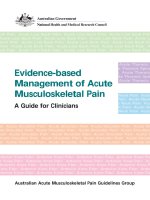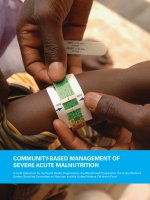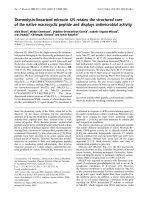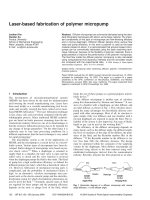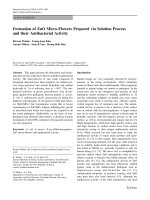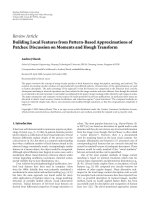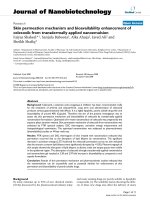Cyclodextrin based nanosponge of norfloxacin: Intestinal permeation enhancement and improved antibacterial activity
Bạn đang xem bản rút gọn của tài liệu. Xem và tải ngay bản đầy đủ của tài liệu tại đây (1.13 MB, 7 trang )
Carbohydrate Polymers 195 (2018) 586–592
Contents lists available at ScienceDirect
Carbohydrate Polymers
journal homepage: www.elsevier.com/locate/carbpol
Cyclodextrin based nanosponge of norfloxacin: Intestinal permeation
enhancement and improved antibacterial activity
T
⁎
Cassiana Mendesa,b, , Gabriela C. Meirellesa, Clarissa Germano Barpc, Jamil Assreuyc,
Marcos A.S. Silvab, Gilles Ponchela
a
CNRS UMR 8612, Université Paris Sud XI, Faculté de Pharmacie, 5 rue J.B. Clément, 92296 Châtenay-Malabry, France
Post Graduation Program in Pharmaceutical Sciences, Quality Control Laboratory, Universidade Federal de Santa Catarina, J/K 207, 88040-900, Florianópolis, SC,
Brazil
c
Department of Pharmacology, Universidade Federal de Santa Catarina, Biological Sciences Centre, Block D, CCB, 88040-900, Florianópolis, SC, Brazil
b
A R T I C LE I N FO
A B S T R A C T
Chemical compounds studied in this article:
Norfloxacin (PubChem CID: 4539)
β-cyclodextrin (PubChem CID: 444041)
Diphenyl carbonate (PubChem CID: 7597)
Nanosponges are a novel class of hyperbranched cyclodextrin-based nanostructures that exhibits remarkable
potential as a drug host system for the improvement in biopharmaceutical properties. This work aims the development of cyclodextrin-based nanosponge of norfloxacin to improve its physicochemical characteristics. βcyclodextrin was used as base and diphenyl carbonate as crosslinker agent at different proportions to produce
nanosponges that were evaluated by in vitro and in vivo techniques. The proportion cyclodextrin:crosslinker
1:2 M/M was chosen due to its higher encapsulation efficiency (80%), revealing an average diameter size of
40 nm with zeta potential of −19 mV. Norfloxacin-loaded nanosponges exhibited higher passage of norfloxacin
in comparison to norfloxacin drug alone by Ussing chamber method. The nanosponge formulation also revealed
a mucoadhesive property that could increase norfloxacin absorption thus improving its antibiotic activity in an
in vivo sepsis model. Therefore, nanosponges may be suitable carrier of norfloxacin to maximize and facilitate
oral absorption.
Keywords:
Cyclodextrin
Intestinal permeability
Mucoadhesion
Nanosponge
Norfloxacin
Ussing chamber
1. Introduction
Cyclodextrins (CD) are well known cyclic structures with a torus
shape that could include hydrophobic molecules into their inner cavity
and improve physicochemical characteristics of many drugs. However,
inclusion complexes with CD were already extensively exploited and
the resulting complexes easily dissociate, besides having a limited
aqueous solubility. Nanosponges (NS) technology arises as a CD-based
host system more efficient in achieving solubilization, stabilization,
enhancement of activity, permeability and bioavailability (Castiglione
et al., 2013; Loftsson & Brewster, 2012; Swaminathan, Cavalli, & Trotta,
2016). NS are a novel class of hyperbranched polymers exhibiting remarkable potential in pharmaceutical and biomedical sciences. Over
the past decade, different NS have been developed based on CD and the
crosslinker tailored for specific applications. Recently, NS have been
applied to removal of pollutants, solubility enhancement, modulation of
drug release, protein delivery, cosmetic carriers, diagnostics, among
others, mainly due to their unique advantage of biodegradability,
biological safety and controlled release (Dora et al., 2016; Leudjo Taka,
Pillay, & Yangkou Mbianda, 2017; Moreira, Andrade, De Araujo,
Kubota, & Gimenez, 2016; Sherje, Dravyakar, Kadam, & Jadhav, 2017).
Norfloxacin (NFX) is a fluoroquinolone antibiotic that have emerged
as one of the preferred agent in the treatment of urinary tract infections
that belongs to biopharmaceutical classification system (BCS) class IV
drugs (Bennett, Dolin, Blaser, & Douglas, 2015; Breda, Jimenez-Kairuz,
Manzo, & Olivera, 2009; O’Donnell & Gelone, 2000). Recently efforts
have been done to improve NFX physicochemical properties and control
the drug delivery (Allou, Yadav, Pal, & Goswamee, 2018; Liu, Chen,
Long, Ma, & Gao, 2018). Previous work of our group confirmed the
intestinal efflux of NFX already described by other groups (Alvarez
et al., 2008; Merino et al., 2006). NFX is captured by uptake transporters but it inhibits them instead of being carried through the enterocyte. As a consequence, NFX is consumed by the uptake transporters thus reducing the drug content able to permeate. This mechanism,
first described by our group, means that there is an additional barrier of
permeability that needs to be circumvented for effective drug
Abbreviations: βCD, β-cyclodextrin; CD, cyclodextrin; DC, diphenyl carbonate; NFX, norfloxacin; NFX NS, NFX-loaded nanosponges; NS, nanosponge
⁎
Corresponding author at: Post Graduation Program in Pharmaceutical Sciences, Quality Control Laboratory, Universidade Federal de Santa Catarina, J/K 207, 88040-900,
Florianópolis, SC, Brazil.
E-mail addresses: (C. Mendes), (G.C. Meirelles), (C.G. Barp), (J. Assreuy),
(M.A.S. Silva), (G. Ponchel).
/>Received 9 February 2018; Received in revised form 6 April 2018; Accepted 4 May 2018
Available online 05 May 2018
0144-8617/ © 2018 Elsevier Ltd. All rights reserved.
Carbohydrate Polymers 195 (2018) 586–592
C. Mendes et al.
determined by light scattering using Nanosizer® N4 PLUS (BeckmanCouter, France) at 90° fixed angle. Samples were appropriated diluted
in Milli-Q® water. The results are the mean hydrodynamic diameter
corresponding to the average of three determinations.
For zeta potential analysis, the samples were diluted in NaCl solution (1 mmol/L) and placed in electrophoretic cells and the zeta potential values were determined from the electrophoretic mobility
measured by Laser Doppler Electrophoresis (Zetasizer Nano series,
Malvern Instruments, Worcestershire, UK).
absorption.
In the last years, oral mucoadhesive systems have been developed as
a promising strategy to prolong the residence time and consequently
increase the drug absoption through gastrointestinal mucosa (Ways,
Lau, & Khutoryanskiy, 2018; Sosnik, Das Neves, & Sarmento, 2014). NS
are a potent host-guest inclusion system but present a limited application in drug delivery mainly due to their inherent lack of cellular
binding capacity. Recently, Singh and coworkers have studied biofunctionalized β-cyclodextrin (βCD) NS aiming increase the cellular
uptake of NS (Singh et al., 2018). Bioadhesion is another property that
could increase the contact between NS and the biological membrane to
direct deliver the drug into the site of action.
Oral bioavailability is a crucial factor for class IV drugs and it will be
the result of the product of the available fraction of administered dose
in the gut lumen, the drug fraction that reaches the inside of the enterocyte cells and the fraction escaping gut and liver metabolism
(Sjöberg et al., 2013). In this context, the aim of this work was to develop a CD-based NS to overcome NFX biopharmaceutical problems.
This study was based on previous work of the group about NFX permeability factors and CD inclusion complexes of NFX that made possible the development of NFX NS for in vitro and in vivo evaluation
(Mendes, Buttchevitz et al., 2015; Mendes, Wiemes et al., 2015). For the
first time, a complete study including the formulation, physicochemical
characterization, release profile, permeability studies by Ussing
chamber model, mucoadhesion evaluation, and in vivo activity was
performed for a NS.
2.2.5. Physicochemical characterization of nanosponges
Differential scanning calorimetry (DSC) curves for NFX, βCD, DC,
their physical mixtures and the NS produced were obtained on a
Shimadzu DSC-60 cell (Shimadzu Corporation, Kyoto, Japan) using
aluminum crucibles with around 2.0 mg of sample in a dynamic N2
atmosphere with a flow rate of 100 mL/min. The heating rate was
10 °C/min and the temperature ranged from 30 °C to 300 °C. The DSC
equipment was previously calibrated with indium (melting point
156.6 °C, ΔH = −28.54 J/g) and zinc (melting point 419.5 °C).
The diffuse reflectance Fourier transform infrared spectroscopy (FTIR) spectra were recorded using a FTIR Frontier spectrophotometer
(PerkinElmer, Brazil), within a scan range of 600–4000 cm−1, with an
average of over 32 scans, at a spectral resolution of 4 cm−1. A background spectrum was obtained for each experimental condition.
Transmission Electron Microscopy (TEM) images were obtained
using TEM JEOL 1400 (Imagif, France) at 60 kv transmission coupled to
TEM domain center software. For the preparation, 10 μL of the NFXloaded NS suspension was diluted to 100 μL of Milli-Q® water and 5 μL
of this dilution was placed on a grid. The grid was disposed on a slide
and inserted in the microscope to visualize samples.
2. Materials and methods
2.1. Materials
βCD, norfloxacin and diphenyl carbonate (DC) were obtained from
Sigma Aldrich (St. Louis, USA). All other analytical reagents were of
analytical grade.
2.2.6. Ussing chambers experiments
This study was carried out with male Wistar rats weighing
210–250 g (Janvier Lab, Paris, France). The animals were housed in a
temperature (22 ± 2 °C) and light- (12 h light/dark cycles) controlled
room, with free access to water and food and fasted 12 h before the
experiment. The studies were approved by the ethics committee of
University of Paris-Sud in accordance with European legislation on
animal experiments.
Different intestinal segments were excised, washed with cold physiological saline solution and visually examined to discard sections
containing Payer’s patches. The tissue was mounted in Ussing chambers
(intestinal surface of 1 cm2) bathed with Ringer’s Krebs bicarbonate
solution at pH 7.4, with mucosal side facing the donor compartment
and serosal side facing the receptor compartment. The system was
maintained at 37 °C and continuously oxygenated with O2/CO2 (95/
5%). NFX (150 μM) or NFX-loaded NS (equivalent to 150 μM) were
placed in the donor chamber and 500 μL were recovered from donor
side and replaced with the same volume of fresh medium every 30 min
until 180 min. Samples of donor side were also recovered to verify any
change in NFX concentration. All samples were analyzed by high performance liquid chromatography (HPLC) validated method as described
above. Tissue viability was assessed during the experiments by continuously recording the transmucosal potential difference. If tissue damage was suspected, the experiment was discarded.
2.2. Methods
2.2.1. Nanosponge preparation
To produce NS, βCD was allowed to react with melted DC at 90 °C
for 5 h using three different proportions of CD:crosslinker (1:2, 1:4 or
1:8 M/M). The solid obtained was ground in a mortar and Soxhlet extraction was realized with ethanol in order to remove unreacted
crosslinker. The resultant solid was dried at 50 °C and stored at 25 °C.
2.2.2. NFX-loaded nanosponges
NFX-loaded nanosponges (NFX NS) were produced weighting NFX
powder and dispersing in aqueous suspension of NS (1:4 w/w) at pH 3
to favor NFX inclusion due to electric charges. This aqueous suspension
was stirred during 24 h protected from light. The final suspension was
centrifuged at 2000 rpm during 10 min to separate the uncomplexed
drug. The colloidal supernatant was separated from the residue and
freeze-dried to produce NFX-loaded NS.
2.2.3. Determination of drug content
The loading of NFX in NS was quantified by high performance liquid
chromatography. These analyses were performed in a Waters 515
pump, a Waters 717 plus autosampler (Milford, MA, USA) and UV detector Waters 486 set at 270 nm. The chromatographic system was
equipped with a Phenomenex® (Torrance, CA, USA) C18 reversed-phase
column (150 × 4.6 mm; 5 μm particle size) kept at 40 °C. The column
was eluted in isocratic mode using a mobile phase consisting of phosphate buffer (0.04 M, pH 3.0) and acetonitrile (84:16 v/v) at a flow rate
of 1.0 mL/min and injection volume of 20 μL (Oliveira et al., 2009).
2.2.7. Nanosponges adhesion experiment
Initially, a little adaptation of Ussing chamber method was used to
investigate the interference of the contact between NS and the intestinal
mucosa. The flow was evaluated in the presence of a semi-permeable
membrane in contact with mucosal side to avoid direct contact between
the NS and the mucosa, in comparison to NFX drug alone. NS adhesion
experiment consisted in allowing NS (150 μM) in Ringer’s Krebs bicarbonate solution to have contact with a delimited intestinal mucosa
surface (2 cm2) at room temperature. Samples of supernatant (non-attached particles) were recovered carefully during 60 min and evaluated
2.2.4. Nanosponges characterization
NS hydrodynamic mean diameter and size distribution were
587
Carbohydrate Polymers 195 (2018) 586–592
C. Mendes et al.
by HPLC. Analyses were realized in triplicate.
2.2.8. In vitro release experiments
Release experiments were conducted in sink conditions using United
States Pharmacopeia apparatus II (paddle) with 300 mL of simulated
intestinal fluid (pH 6.5) maintained at 37 ± 0.5 °C and stirred at
75 rpm. NFX-loaded NS (equivalent to 10 mg) were placed into semipermeable membranes (commercial dialysis cellulose membranes MW
cut-off 12,000 Da, Sigma-Aldrich, St. Louis, MO, USA) and aliquots of
5 mL of the medium were withdrawn at intervals of 5, 15, 25, 30, 45,
60, 90, 120, 150 and 180 min. The samples were analyzed by HPLC and
the curve of percent of NFX released from NS versus time was constructed.
2.2.9. Antimicrobial in vivo experiments
Animal procedure were performed in accordance with the National
Institutes of Health Guidelines and approved by the Institutional
Animal Care and Use Committee of Universidade Federal de Santa
Catarina (CEUA/UFSC-PP00790). Sepsis was induced by cecal ligation
and puncture (CLP) as previously described (Rittirsch et al., 2008).
Briefly, female rats (∼200 g) were pre-anesthetized with xylazine
(5 mg/kg, i.p.) and tramadol hydrochloride (10 mg/kg, i.p.), then anesthetized with isofluorane (5% for induction and 3% for maintenance).
After laparotomy, the cecum was ligated distal to the ileocecal valve,
punctured two times with 14-gauge needle and a small amount of cecal
content was squeezed through the punctures. The cecum was placed
back into the abdominal cavity and walls were sutured. All animals
received warmed saline (30 mL/kg, s.c) after the surgery.
One hour after sepsis induction, NFX (10 mg/kg) or NFX-NS (10 mg/
kg) were administrated by gavage and then animals were kept under
standard laboratory conditions, with temperature (23 ± 2 °C), lightcontrolled room (12 h light/dark cycle), and free access to water and
food. Tramadol hydrochloride (5 mg/kg, s.c.) was injected 12 h after
surgery as analgesic procedure. Twenty four hours after treatment,
animals were sacrificed by anesthetic overdose (ketamine/xylazine)
and then the kidneys were aseptically harvested, homogenized and
plated. A 2 μL of each aliquot of serial dilutions (10−1, 10−2 and 10−3)
was plated onto Mueller-Hinton agar plate and incubated at 32–35 °C
for 16–18 h for colony count determination (CLSI, 2015). The total
count of CFU/mL in the original inoculum was used to compare NS and
NFX drug alone and data are expressed as the mean ± S.E.M. Statistical significance was analyzed by Kruskal-Wallis test followed by
Dunn’s post hoc test as indicated in figure legends. A p value of less than
0.05 was considered significant. Statistical tests were performed using
Graph Pad Prism 5 for Windows (Graph Pad Software, La Jolla, CA).
Fig. 1. Differential scanning calorimetry curves of Norfloxacin (NFX), β-cyclodextrin (βCD), diphenyl carbonate (DC), Nanosponge (NS), NFX-loaded
Nanosponge (NFX NS).
wide endothermic peak at 87.72 °C (ΔH −368.57 J/g) related to the
loss of water from the inner cavity and the crosslinker DC revealed an
endothermic peak at 78.41 °C (ΔHfusion −123.7 J/g). In NS thermal
analysis it was not possible to observe the separated components, only
one endothermic event at 62.23 °C (ΔH −222.86 J/g) related to the
remaining water from the NS production. The same water is observed in
NFX-loaded NS at 56.57 °C (ΔH −96.76 J/g) and one of NFX characteristic endothermic points could be observed at 225.73 °C (ΔH
−83.05 J/g).
The FT-IR spectra of the samples are illustrated in Fig. 2. NFX
spectrum presents the characteristic bands at 1720 cm−1 corresponding
to COOH stretching and at 1606 cm−1 corresponding to pyridone keto.
In the spectra of the excipients (βCD and DC), it is possible to verify the
characteristic bands of each component. The NS spectrum revealed an
additional band not observed in the components isolated at 1612 cm−1,
which reveals the polymeric structure formation between βCD and DC.
The NFX NS spectrum is very similar to NS spectrum, differing only in
the intensity. It is important to notice that NFX bands could not be seen
in NFX NS spectrum.
TEM observations showed the cylindrical form of the NS (Fig. 3).
There is no difference of shape and size between NFX-loaded and unloaded NS.
3. Results
3.1. Nanosponges characterization
After the NS preparation, the NFX content was evaluated by HPLC.
Three different proportions of CD:crosslinker (1:2, 1:4 or 1:8 M/M)
were prepared and revealed a NFX content of 80, 76 and 70%, respectively. The total content was determined by HPLC and the chromatograms are shown in lementary material. Due to the higher drug
content, the proportion 1:2 (M/M) was selected to produce the NS used
throughout the studies. NS hydrodynamic mean diameter and size
distribution were determined and revealed a mean size of 40 nm with a
potential zeta of −19 mV (Supplementary material).
3.3. Ussing chambers experiments
Ussing chamber experiment with NFX and NFX-loaded NS mucosalto-serosal (M-S) and serosal-to-mucosal (S-M) at 37 °C are expressed as
percentage of NFX that permeates (Fig. 4A). The permeability values
are expressed in Table 1. NFX-loaded NS presents a higher passage of
NFX in both directions in comparison to NFX drug alone. Permeability
values are higher to NFX-loaded NS in comparison to NFX drug alone at
duodenum and ileum (P < 0.05). It is important to notice that NFX
passage is not statistically different when comparing mucosal-to-serosal
(M-S) and serosal-to-mucosal (S-M) for NFX drug alone or loaded in NS.
NFX and NFX-loaded NS flow at different portions of rat intestine
were evaluated and the results are shown in Fig. 5. It can be observed
3.2. Physicochemical characterization of nanosponges
DSC curves were obtained and the results are expressed in Fig. 1.
NFX showed two endothermic events at 223.85 °C (ΔH −116.52 J/g)
and 209.73 °C (ΔH −14.9 J/g) corresponding to the melting point of
NFX form B (Barbas, Martí, Prohens, & Puigjaner, 2006). βCD showed a
588
Carbohydrate Polymers 195 (2018) 586–592
C. Mendes et al.
were evaluated also for adhesion test and revealed less than 5% of NFX
attached (data not shown).
3.5. NFX-loaded NS release
In order to characterize the release of NFX from NS, the in vitro drug
release was performed (Fig. 7). NFX-loaded revealed a typical and
controlled release from the NS to the dissolution media at pH 6.5 with
100% reached at 150 min, confirming the strong interaction between
NFX and NS, interaction stronger than simple inclusion complexes with
βCD (Mendes, Buttchevitz et al., 2015).
3.6. Antimicrobial in vivo experiments
In order to evaluate the antibacterial activity of NS, CLP model was
used. According to CLP standardization, animals presented a survival of
50% after 48 h. Therefore, the time of 24 h was chosen to harvest the
kidney due to the number of surviving animals at this time point (initial
of 6 animals per group). The kidney was the organ chosen to antibacterial evaluation since NFX is largely used in clinical to UTI
(O’Donnell & Gelone, 2000). Fig. 8 shows the smaller number of CFU/
mL detected in the kidney of animals treated with NFX-loaded NS when
compared to animals treated with NFX drug alone.
4. Discussion
Our group revealed recently the intestinal permeability determinants of NFX in Ussing chamber model and realized that the intestinal
transport of this drug is related to its zwitterionic form at biological pH.
Aiming an original formulation that could overcome the biopharmaceutical problems as the intestinal transporters issues, NFX-loaded NS at
nanoscale were successfully obtained by the combination of 1:2 M/M
CD:crosslinker with high NFX content.
DSC analysis did not show the endothermic events of NS components in the NS curve, evidencing the NS formation. NFX-loaded NS
analysis showed one endothermic event of NFX fusion, confirming that
NFX is not totally included in the NS. The FT-IR analyses corroborate
with NS formation, being an indicative of the strong interactions between the components of NS. The absence of NFX bands reveals that
there is no enough crystalline drug in superficial level to be observed in
NFX-loaded NS spectrum. Photomicrographs obtained by TEM analyses
revealed the cylindrical shape of NS formed, corroborating with the
cyclic structure proposed by Swaminathan and coworkers
(Swaminathan, Vavia, Trotta, & Torne, 2007).
In the Ussing chamber experiments, NFX-loaded NS presented
higher NFX passage in comparison to drug alone in both direction,
mucosal-to-serosal (M-S) and serosal-to-mucosal (S-M). Since NFX
presents four different pKa values, as already determined experimentally by our group, the pH of Ringer’s Krebs Bicarbonate solution (pH
7.4) was maintained to all intestinal segments evaluated, both to NFX
drug alone and NFX-loaded NS. The same pH was used to verify only
the difference in intestinal flow and permeability between the drug
alone and the NS system, and not to verify the difference in intestinal
passage because of the drug ionization.
Regarding the intestinal flow, it was not statistically different between the intestinal segments when comparing NFX-loaded NS to NFX
drug alone. NFX-loaded NS presented higher permeability coefficient
values in duodenum and ileum. This difference is probably related to
the transporters that are differently expressed along the intestinal tract.
NFX drug alone has an affinity to some intestinal uptake transporters
and acts as an inhibitor thus depleting NFX amount and hence decreasing its passage. NFX-loaded in NS probably ionize differently from
NFX drug alone, as already observed to βCD inclusion complexes with
NFX produced by our group (Mendes, Buttchevitz et al., 2015), which
could influence the transporters capture. If NFX-loaded in NS is not a
substrate of this depletion, the amount of NFX able to permeate from NS
Fig. 2. Fourier transform infrared spectroscopy spectra of Norfloxacin (NFX), βcyclodextrin (βCD), diphenyl carbonate (DC), Nanosponge (NS) and NFXloaded Nanosponge (NFX NS).
Fig. 3. TEM observations of nanosponges (NS). The black bar at the bottom left
is equivalent to 200 nm.
that NFX presents a flow variation between different intestinal parts,
differently of NFX-loaded NS that presents an intestinal flow more similar between different regions. When comparing NFX-loaded NS to
NFX at each intestinal segment, there is no statistical difference
(P > 0.05) of flow between them.
3.4. Nanosponge adhesion experiment
The influence of the contact with the mucus layer in NFX intestinal
passage was investigated in Ussing chamber model by using a semipermeable membrane in mucosa side. The results of NFX that permeates from NFX drug alone or NFX-loaded NS are shown in Fig. 4B. It
could be observed the influence that mucus layer present in the NFX
passage in the case of NS formulation. Therefore, the mucoadhesion
experiment was evaluated during time in jejunum and colon due to
their higher surface. The percentage of NFX attached is expressed in
Fig. 6. NFX as drug alone and inclusion complexes of NFX and βCD
589
Carbohydrate Polymers 195 (2018) 586–592
C. Mendes et al.
Fig. 4. Norfloxacin (NFX) and NFX-loaded nanosponge
(NS) (%) that permeates during 180 minutes at 37 °C: (A)
mucosal-to-serosal (M-S) and serosal-to-mucosal (S-M), (B)
in mucosal and serosal side and in presence and absence of
semi-permeable membrane. (A) * P < 0.05 when compared NS with NFX M-S or S-M. (B) * P < 0.05 when
compared NS with NS membrane, NFX or NFX membrane.
# P < 0.05 when compared NS mucosal to NFX mucosal.
Table 1
Apparent permeability values (Papp) of NFX determined from Ussing chamber
experiments in mucosal-to-serosal (M-S) at 37 °C, experiments realized with
duodenal portions.
Sample
NFX
NFX-loaded NS
Papp (×10−6 cm/s)
Duodenum
Jejunum
Ileum
Colon
1.07 ± 0.18
3.23 ± 0.44
3.30 ± 0.36
3.33 ± 0.43
3.63 ± 0.69
5.26 ± 0.22
1.08 ± 0.73
1.60 ± 0.99
Fig. 6. Norfloxacin-loaded Nanosponge attached to the mucus layer (% attached) at jejunum and colon during 60 min. Results are expressed as
mean ± SD (n = 3).
Fig. 5. Norfloxacin intestinal flow (×10−12 nmol/cm2/s) at different portions
of rat intestine (duodenum, jejunum, ileum and colon) from Norfloxacin drug
alone (NFX) or NFX-loaded nanosponges.
would be bigger than NFX drug alone. This hypothesis was confirmed
by NFX quantification into the donor chamber (mucosal side). The results revealed (Fig. 4B) an increased NFX quantity able to permeate of
NFX-loaded in comparison to NFX drug alone, confirming our hypothesis that NS could protect NFX from uptake transporters depletion. This
protection is related to the ionic charges since the uptake transporters
that deplete NFX are organic cation carnitine transporters (OCTN) and
organic anion transporter polypeptide (OATP). These results explain
the difference observed in permeability but not in intestinal flow, since
permeability takes into account the initial content able to permeate,
which is increased for NFX-loaded NS.
Fig. 7. Release profile of norfloxacin (NFX) from nanosponge (NS) in intestinal
simulated fluid (pH 6.5).
The intestinal flow test in presence of semipermeable membrane
revealed an important effect in the intestinal passage of NFX-loaded NS
when in contact with the mucosal layer. Therefore, the ability of NS to
interact with mucin glycoproteins or other mucus components being
immobilized in the mucosal layer was evaluated. The mucoadhesion
experiment has shown an increasing quantity of NFX attached when
loaded in NS during 60 min in jejunum and even higher in the colon.
590
Carbohydrate Polymers 195 (2018) 586–592
C. Mendes et al.
resulted in a mucoadhesive formulation with enhanced permeability
and antibacterial activity in comparison with the drug alone. The NFXloaded NS presented a controlled release of NFX which extended the in
vivo antibacterial activity in rats caused.
This novel mucoadhesive NFX-loaded NS represents a promising
approach to overcome NFX limitation in absorption. NS might be suitable carrier of NFX and consequently it could reduce the dose required
due to its better antibacterial activity. This system may increase the
therapeutic benefits being a potential alternative to the existing NFX
drug formulations.
Fig. 8. Effects of oral treatment of nanosponge on bacterial growth. The graph
shows the bacterial growth in kidneys harvested 24 h after the treatment of
animals treated 1 h after sepsis induction. The results show the mean ± S.E.M
of 5–6 animals per group (CLP + Veh: 5; NFX: 5; NS: 6 animals). Once the
results do not show normal distribution, Kruskal-Wallis followed by Dunn’s
post-test was used for statistical analysis. * P < 0.05 when compared NS with
the CLP + Veh group and # P < 0.05 when compared NS with the corresponding NFX group.
Acknowledgment
This study was supported by Coordination for Enhancement of
Higher Education Personnel (CAPES – Brazil), Process n° BEX 3132/153.
Appendix A. Supplementary data
Supplementary data associated with this article can be found, in the
online version, at />
The higher mucoadhesion in colon is expected since it has two-layered
mucus while jejunum present only one layer of mucus (Hansson, 2012).
It is important to highlight that the quantity of NFX attached in the
mucoadhesion experiment is at 2 cm2 of the intestinal segment. Extrapolating to an in vivo system, the gastrointestinal transit will increase
this percentage. The mucoadhesion ability of NS could explain the
higher intestinal passage, because mucoadhesive property prolongs the
residence time of NS in the mucosal layer of intestinal epithelial cells,
increasing the quantity of NFX that permeates. The NS mucoadhesion
was not caused by electrostatic interactions since the zeta potential is
negative and the charge of proteins in mucus layer is also negative.
Therefore, the bioadhesion is probably related to hydrogen bonds and/
or hydrophobic interactions between the chemical groups of NS and the
mucus layer (Boddupalli, Mohammed, Nath, & Banji, 2010; Carvalho,
Bruschi, Evangelista, & Gremião, 2010). This mucoadhesion implies in
the extension of the contact time between the NFX NS and the intestinal
mucusal, which could increase the absorption.
CLP model used in the antibacterial activity assay is the most accepted model used for experimental sepsis and is considered a gold
standard method to mimic human sepsis. Rodents with sepsis induced
by CLP, like humans, also respond to antibiotics (Dellinger et al., 2008;
Kumar, 2011; Mayr, Yende, & Angus, 2014; Rittirsch et al., 2008). Rats
treated with NFX-loaded NS presented a smaller number of CFU when
compared to animals treated with NFX drug alone. This pharmacodynamic effect is probably related to the higher solubility of the drug in
NS system, higher intestinal flow observed in Ussing chambers and the
mucoadhesion caused by this system. The NS as a mucoadhesive system
could extend the contact time between NFX and the mucus layer, increasing its absorption, which will lead to a better antibacterial activity
even after 24 h after treatment.
Interestingly, antibacterial activity revealed that NFX drug alone
was not different from CLP + Vehicle in the timepoint evaluated. This
fact is probably related to the release profile of NS that presented a slow
and more controlled release of NFX than the drug already dissolved.
NFX-loaded NS presented a controlled release of NFX which could extend the drug effect. This difference could explain the effect observed in
24 h to NFX-loaded NS and not to NFX drug alone.
References
Allou, N. B., Yadav, A., Pal, M., & Goswamee, R. L. (2018). Biocompatible nanocomposite
of carboxymethyl cellulose and functionalized carbon–norfloxacin intercalated
layered double hydroxides. Carbohydrate Polymers, 186(September (2017)), 282–289.
/>Alvarez, A. I., Pérez, M., Prieto, J. G., Molina, A. J., Real, R., & Merino, G. (2008).
Fluoroquinolone efflux mediated by ABC transporters. Journal of Pharmaceutical
Sciences, 97(9), 3483–3493. />Barbas, R., Martí, F., Prohens, R., & Puigjaner, C. (2006). Polymorphism of norfloxacin:
Evidence of the enantiotropic relationship between polymorphs A and B. Crystal
Growth and Design, 6(6), 1463–1467. />Bennett, J. E., Dolin, R., Blaser, M. J., & Douglas, R. G. (2015). (8th ed.). Mandell, Douglas,
and Bennett’s principles and practice of infectious diseasesVol. 8Elsevier Health
Sciences />Boddupalli, B., Mohammed, Z., Nath, R., & Banji, D. (2010). Mucoadhesive drug delivery
system: An overview. Journal of Advanced Pharmaceutical Technology & Research, 1(4),
381. />Breda, S. A., Jimenez-Kairuz, A. F., Manzo, R. H., & Olivera, M. E. (2009). Solubility
behavior and biopharmaceutical classification of novel high-solubility ciprofloxacin
and norfloxacin pharmaceutical derivatives. International Journal of Pharmaceutics,
371(1–2), 106–113. />CLSI (2015). Methods for dilution antimicrobial susceptibility tests for bacteria that grow
aerobically. Approved standard-tenth edition. CLSI document M07-A10. .
org/10.4103/0976-237X.91790.
Carvalho, F. C., Bruschi, M. L., Evangelista, R. C., & Gremião, M. P. D. (2010).
Mucoadhesive drug delivery systems. Brazilian Journal of Pharmaceutical Sciences,
46(1), 1–17. />Castiglione, F., Crupi, V., Majolino, D., Mele, A., Panzeri, W., Rossi, B., ... Venuti, V.
(2013). Vibrational dynamics and hydrogen bond properties of β-CD nanosponges:
An FTIR-ATR, Raman and solid-state NMR spectroscopic study. Journal of Inclusion
Phenomena and Macrocyclic Chemistry, 75, 247–254. />s10847-012-0106-z.
Dellinger, R., Levy, M., Carlet, J., Bion, J., Parker, M., Jaeschke, R., ... Vincent, J. (2008).
Surviving Sepsis Campaign: international guidelines for management of severe sepsis
and septic shock: 2008. Intensive Care Medicine, 34, 17–60. />1007/s00134-007-0934-2.
Dora, C. P., Trotta, F., Kushwah, V., Devasari, N., Singh, C., Suresh, S., & Jain, S. (2016).
Potential of erlotinib cyclodextrin nanosponge complex to enhance solubility, dissolution rate, in vitro cytotoxicity and oral bioavailability. Carbohydrate Polymers,
137, 339–349. />Hansson, G. C. (2012). Role of mucus layers in gut infection and inflammation. Current
Opinion in Microbiology, 15(1), 57–62. />Kumar, A. (2011). Optimizing antimicrobial therapy in sepsis and septic shock. Critical
Care Nursing Clinics of North America, 23(1), 79–97. />ccell.2010.12.005.
Leudjo Taka, A., Pillay, K., & Yangkou Mbianda, X. (2017). Nanosponge cyclodextrin
polyurethanes and their modification with nanomaterials for the removal of pollutants from waste water: A review. Carbohydrate Polymers, 159, 94–107. .
org/10.1016/j.carbpol.2016.12.027.
Liu, D.-E., Chen, Q., Long, Y.-B., Ma, J., & Gao, H. (2018). A thermo-responsive polyurethane organogel for norfloxacin delivery. Polymer Chemistry, 9, 228–235. http://
dx.doi.org/10.1039/C7PY01803G.
Loftsson, T., & Brewster, M. E. (2012). Cyclodextrins as functional excipients: Methods to
enhance complexation efficiency. Journal of Pharmaceutical Sciences, 101(9),
3019–3032. />
5. Conclusion
In conclusion, we successfully produced a norfloxacin-loaded nanosponge system that improved drug characteristics. The physicochemical evaluation revealed the chemical interaction between the βCD
and the crosslinker to form the NS structure and the insertion of NFX in
the system, since it could not be observed NFX events in thermal and
spectroscopically analysis. The association of NFX in the βCD-based NS
591
Carbohydrate Polymers 195 (2018) 586–592
C. Mendes et al.
tablets. Journal of Chromatographic Science, 47(9), 1–6.
Rittirsch, D., Flierl, M. A., Nadeau, B. A., Day, D. E., Huber-Lang, M., Mackay, C. R., &
Ward, P. A. (2008). Functional roles for C5a receptors in sepsis. Nature Medicine,
14(5), 551–557. />Sherje, A. P., Dravyakar, B. R., Kadam, D., & Jadhav, M. (2017). Cyclodextrin-based
nanosponges: A critical review. Carbohydrate Polymers, 173(1), 37–49. .
org/10.1016/j.carbpol.2017.05.086.
Singh, P., Ren, X., Guo, T., Wu, L., Shakya, S., He, Y., & Zhang, J. (2018).
Biofunctionalization of β-cyclodextrin nanosponges using cholesterol. Carbohydrate
Polymers, 190, 23–30. />Sjöberg, Å., Lutz, M., Tannergren, C., Wingolf, C., Borde, A., & Ungell, A. L. (2013).
Comprehensive study on regional human intestinal permeability and prediction of
fraction absorbed of drugs using the Ussing chamber technique. European Journal of
Pharmaceutical Sciences, 48(1–2), 166–180. />10.007.
Sosnik, A., Das Neves, J., & Sarmento, B. (2014). Mucoadhesive polymers in the design of
nano-drug delivery systems for administration by non-parenteral routes: A review.
Progress in Polymer Science, 39(12), 2030–2075. />progpolymsci.2014.07.010.
Swaminathan, S., Vavia, P. R., Trotta, F., & Torne, S. (2007). Formulation of betacyclodextrin based nanosponges of itraconazole. Journal of Inclusion Phenomena and
Macrocyclic Chemistry, 57, 89–94. />Swaminathan, S., Cavalli, R., & Trotta, F. (2016). Cyclodextrin-based nanosponges: A
versatile platform for cancer nanotherapeutics development. Wiley Interdisciplinary
Reviews: Nanomedicine and Nanobiotechnology, 8(4), 579–601. />1002/wnan.1384.
Ways, T. M., Lau, W., & Khutoryanskiy, V. (2018). Chitosan and its derivatives for application in mucoadhesive drug delivery systems. Polymers, 10(3), 267. .
org/10.3390/polym10030267.
Mayr, F. B., Yende, S., & Angus, D. C. (2014). Epidemiology of severe sepsis. Virulence,
5(1), 4–11. />Mendes, C., Buttchevitz, A., Barison, A., Ocampos, F. M. M., Bernardi, L. S., Oliveira, P. R.,
& Silva, M. A. S. (2015). Investigation of β-cyclodextrin-norfloxacin inclusion complexes. Part 2. Inclusion mode and stability studies. Expert Review of Anti-Infective
Therapy, 13(1), 131–140. />Mendes, C., Wiemes, B. P., Buttchevitz, A., Christ, A. P., Ribas, K. G., Adams, A. I. H., &
Oliveira, P. R. (2015). Investigation of β-cyclodextrin-norfloxacin inclusion complexes. Part 1. Preparation, physicochemical and microbiological characterization.
Expert Review of Anti-Infective Therapy, 13(1), 119–129. />14787210.2015.982091.
Merino, G., Álvarez, A. I., Pulido, M. M., Molina, A. J., Schinkel, A. H., & Prieto, J. G.
(2006). Breast cancer resistance protein (BCRP/ABCG2) transports fluoroquinolone
antibiotics and affects their oral availability, pharmacokinetics, and milk secretion.
Drug Metabolism and Disposition, 34(4), 690–695. />105.008219.
Moreira, M. P., Andrade, G. R. S., De Araujo, M. V. G., Kubota, T., & Gimenez, I. F. (2016).
Ternary cyclodextrin polyurethanes containing phosphate groups: Synthesis and
complexation of ciprofloxacin. Carbohydrate Polyme, 151, 557–564. .
org/10.1016/j.carbpol.2016.05.101.
O’Donnell, J. A., & Gelone, S. P. (2000). Fluoroquinolones. Infectious Disease Clinics of
North America, 14(2), 489–513. />Oliveira, P. R., Bernardi, L. S., Mendes, C., Cardoso, S. G., Sangoi, M. S., & Silva, M. A. S.
(2009). Liquid chromatographic determination of norfloxacin in extended-release
592
